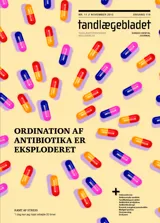Emfysem på hoved-hals og i mediastinum efter brug af air-rotor
Tandlæger bør ikke anvende airrotor til dento-alveolærkirurgiske procedurer. Ovenstående patienttilfælde illustrerer de alvorlige konsekvenser, dette kan medføre.
Baggrund – Anvendelse af airrotor til kirurgiske dento-alveolære procedurer kan medføre subkutant emfysem og pneumomediastinum, der i værste fald er livstruende.
Patienttilfælde – En 29-årig kvinde fik foretaget kirurgisk fjernelse af en horisontalt lejret 3. molar i underkæben med anvendelse af airrotor. Patienten blev dagen efter indlagt med hævelse og subkutan krepetition fra tindingetil clavicula-niveau. CT-scanning viste ud over cerviko-facialt emfysem også fri luft i mediastinum. Efter en uges indlæggelse med intravenøs antibiotikabehandling kunne hun udskrives i velbefindende.
Konklusion – Tandlæger bør ikke anvende airrotor til dento-alveolærkirurgiske procedurer. Ovenstående patienttilfælde illustrerer de alvorlige konsekvenser, dette kan medføre.
Background – Use of airrotor for dentoalveolar surgery can lead to subcutaneous emphysema and pneumomediastinum that can be life threatening.
Case Study – A 29 year old female underwent surgical removal of a horizontally placed mandibular third molar with the use of airrotor. The following day the patient was admitted to the hospital with swelling and subcutaneous crepitation from the temple region to the clavicular level. A CT-scan revealed cervicofacial emphysema and free air in the mediastinum. The patient was discharged in good condition after one week of iv-antibiotic treatment.
Conclusion – Dentists should not use airrotor for dentoalveolar surgery. The above case illustrates the serious consequences this can lead to.


